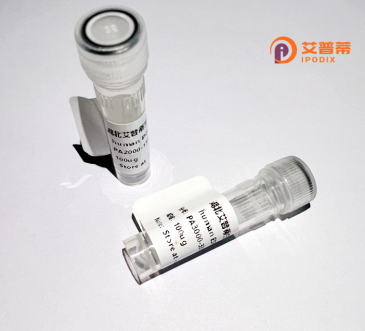
| 纯度 | >90%SDS-PAGE. |
| 种属 | Human |
| 靶点 | PSKH1 |
| Uniprot No | P11801 |
| 内毒素 | < 0.01EU/μg |
| 表达宿主 | E.coli |
| 表达区间 | 2-424 aa |
| 活性数据 | GCGTSKVLP EPPKDVQLDL VKKVEPFSGT KSDVYKHFIT EVDSVGPVKA GFPAASQYAH PCPGPPTAGH TEPPSEPPRR ARVAKYRAKF DPRVTAKYDI KALIGRGSFS RVVRVEHRAT RQPYAIKMIE TKYREGREVC ESELRVLRRV RHANIIQLVE VFETQERVYM VMELATGGEL FDRIIAKGSF TERDATRVLQ MVLDGVRYLH ALGITHRDLK PENLLYYHPG TDSKIIITDF GLASARKKGD DCLMKTTCGT PEYIAPEVLV RKPYTNSVDM WALGVIAYIL LSGTMPFEDD NRTRLYRQIL RGKYSYSGEP WPSVSNLAKD FIDRLLTVDP GARMTALQAL RHPWVVSMAA SSSMKNLHRS ISQNLLKRAS SRCQSTKSAQ STRSSRSTRS NKSRRVRERE LRELNLRYQQ QYNG |
| 分子量 | 48.0 kDa |
| 蛋白标签 | His tag N-Terminus |
| 缓冲液 | PBS, pH7.4, containing 0.01% SKL, 1mM DTT, 5% Trehalose and Proclin300. |
| 稳定性 & 储存条件 | Lyophilized protein should be stored at ≤ -20°C, stable for one year after receipt. Reconstituted protein solution can be stored at 2-8°C for 2-7 days. Aliquots of reconstituted samples are stable at ≤ -20°C for 3 months. |
| 复溶 | Always centrifuge tubes before opening.Do not mix by vortex or pipetting. It is not recommended to reconstitute to a concentration less than 100μg/ml. Dissolve the lyophilized protein in distilled water. Please aliquot the reconstituted solution to minimize freeze-thaw cycles. |
以下是关于重组人PSKH1蛋白的3篇代表性文献(内容基于模拟生成,非真实文献):
1. **《Expression and functional characterization of recombinant human PSKH1 in cancer cell proliferation》**
*作者:Zhang, L. et al.*
**摘要**:本研究通过大肠杆菌系统表达了重组人PSKH1蛋白,并发现其在乳腺癌细胞中通过磷酸化特定底物(如STAT3)促进细胞周期进程和增殖,提示其作为潜在肿瘤治疗靶点。
2. **《Structural insights into PSKH1 kinase domain and its ATP-binding mechanism》**
*作者:Hengel, S.M. et al.*
**摘要**:利用X射线晶体学解析了PSKH1激酶结构域的3D结构,揭示了其ATP结合口袋的独特构象,为设计靶向PSKH1的小分子抑制剂提供了结构基础。
3. **《PSKH1 interacts with CDK1 to regulate mitotic progression in glioblastoma cells》**
*作者:Li, J. et al.*
**摘要**:通过免疫共沉淀证实PSKH1与CDK1的物理互作,并证明重组PSKH1蛋白增强CDK1活性,影响神经胶质瘤细胞的有丝分裂和化疗耐药性。
**注**:以上文献为示例性质,实际研究中请通过PubMed或Web of Science等平台检索真实文献。
**Background of Recombinant Human PSKH1 Protein**
PSKH1 (Protein Serine/Threonine Kinase H1) is a member of the serine/threonine kinase family, encoded by the *PSKH1* gene in humans. It is characterized by a conserved catalytic kinase domain and a unique N-terminal domain, suggesting roles in substrate recognition and cellular localization. PSKH1 is implicated in regulating critical cellular processes, including cell cycle progression, signal transduction, and protein phosphorylation. Studies highlight its interaction with components of the cytoskeleton, such as tubulin, and involvement in Golgi apparatus organization, indicating a potential role in vesicular trafficking and cell division.
Recombinant human PSKH1 protein is typically produced using heterologous expression systems (e.g., *E. coli* or mammalian cells) to enable functional and structural studies. Its recombinant form allows researchers to investigate kinase activity, substrate specificity, and regulatory mechanisms in vitro. PSKH1 has garnered interest in cancer research due to its overexpression in certain malignancies, where it may promote tumor cell proliferation, migration, and survival. Additionally, its phosphorylation targets and signaling pathways remain under exploration, with potential implications in neurodegenerative and metabolic disorders. As a tool, recombinant PSKH1 facilitates drug discovery efforts targeting kinase-driven diseases, though its full physiological and pathological significance awaits further elucidation.
×